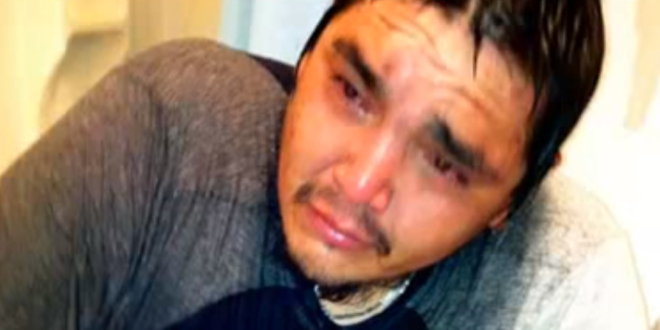Onkwehon:we (Original Peoples) – Week in Review (August 5-11, 2013)
‘Onkwehonwe’ is a word used by Haudenosaunee peoples (also known as the Six Nations Confederacy) that means ‘original peoples’ and refers to all Indigenous peoples of Turtle Island (North America).
by Steve da Silva – Reproduced from the
Two Row Times
Flood Evacuees of Siksika Nation Living in Prison Camp-Like Conditions

Warren Drunken Chief, with his son Matthew Littlechild, 8, is living with his family in campers on a hill above their flood-damaged homes. There is no running water and the one generator they had is broken.
Photograph by: Lorraine Hjalte, Calgary Herald
No smoking, no pets, no ‘vulgar language’, an imposed curfew and no ‘inappropriate clothing’ – such as women wearing shorts or tank tops. These are just a few of the ‘rules’ that flood evacuees of the Siksika First Nation are being subjected to after having to flee heavy flooding along the Bow River. While many regions affected by floodwaters that swept through Alberta in June 2013 have been quickly restored, members of Siksika Firs t Nation have been waiting weeks to return home, even after flood waters receded.
The camp, which is policed by a private security company, contrasts sharply with the relatively comfortable amenities and support provided to evacuees of the town of High River.
The Siksiká are one of the four nations of the ‘Blackfoot Confederacy,’ known as the Niitsítapi (‘Original People’) in the Blackfoot dialects. The ancestral lands of the Niitsítapi span much of southern Alberta, Saskatchewan, Montana, and part North Dakota.
CSIS, Aboriginal Affairs Involved in Widespread Surveillance During Idle No More
Recent reports attained by the Canadian Press through access-to-information requests reveal the extent to which Canada’s spy agency kept tabs on the Idle No More movement throughout December 2012 and January 2013. Aboriginal Affairs, CSIS, and the Integrated Terrorism Assessment Center (ITAC), cooperated in monitoring and creating ‘threat assessments’ of the Indigenous protests, of which they documented 439 over the two month period.
Investigative journalist Tim Groves of Toronto revealed in July 2013 that CSIS is currently deploying a recruitment strategy to bring on board more Aboriginal people and ‘visible minorities’. The spy agency’s internal reports revealed that they had 55 “Aboriginal employees” as of 2012, which they were seeking to increase to 111.
Beating of 24-year-old Innu man by Quebec police caught on camera
A video of two Quebec police (Sûreté du Québec) officers beating a 24-year-old Innu man in Unamen Shipu territory in northeastern Quebec has gone viral.
The YouTube video
shows Norbert Mestenapeo – who does not appear to be resisting – receiving multiple blows to the head. The assault occurred in La
 Romaine, an Innu First Nation community. Unamen Shipu had its own police force until 2008, when it could no longer operate due to budgetary constraints, at which point policing was taken over by Sûreté du Québec.
Romaine, an Innu First Nation community. Unamen Shipu had its own police force until 2008, when it could no longer operate due to budgetary constraints, at which point policing was taken over by Sûreté du Québec.
The incident has been seized upon by the Assembly of First Nations of Quebec to call for a return to Aboriginal policing of the community. Grand chief of Unamen Shipu, Raymond Bellefleur, said of the incident : “Police come here and they can’t speak the Montagnais language and they never stay for more than a week. How can you effectively patrol a place you know nothing about?”
APTN has license renewed for 5 years
The Canadian Radio-television and Telecommunications Commission (CRTC) renewed the ‘mandatory carriage’ license of APTN for another five years, providing the Aboriginal broadcaster with a place on basic cable and $38 million in funding that comes with it. APTN provides programming in 30 different Onkwehon:we languages, as well as English and French. APTN had applied for an increase of its subscriber fees from 25 to 40 cents, but received 31 cents per cable subscriber.
Sun Media, notorious for its rightwing anti-native, anti-working-class, and anti-immigrant editorializing, had its application for ‘mandatory carriage’ on basic cable rejected. But the CRTC’s compromise solution directed all television networks to offer all-Canadian national news services, which would encourage cable providers to pick up Sun Media in their basic cable packages.
Three Indigenous women killed in Toronto in last few months

Bella Laboucan-McLean
Bella Laboucan-McLean is the latest victim on the long list of Onkwehon:we women who have been murdered, disappeared, or have died under suspicious circumstances in Canada. Laboucan-McLean, the young Sturgeon Lake Cree First Nation woman who had just graduated from Humber College, was found dead on July 20 after having plunging 31 storeys to the ground from a downtown Toronto condo she was visiting.
Two other women in their 20s have died in highly suspicious circumstances in Toronto this summer as well. Cheyenne Fox from Sheguiandah First Nation also plunged to her death from a condo in April. In May, Terra Gardner was killed by a freight train near Yonge and Summerhill after having received death threats at a time when she had been compelled to testify in an upcoming murder trial.
The United Nations Committee on Elimination of Discrimination Against Women will be sending special rapporteurs to Canada this summer and fall, finally responding to the awareness and pressure generated by years of work of grassroots Indigenous women and supporting activists who have drawn attention to the nearly 600 documented cases of missing or murdered Indigenous women.
Federal Conservative Justice Minister Peter McKay recently dismissed calls for a national Inquiry into missing and murdered Indigenous women that was backed by provincial and territorial leaders meeting at the Niagara-On-The-Lake Summit after their meeting with aboriginal leaders.
Comments